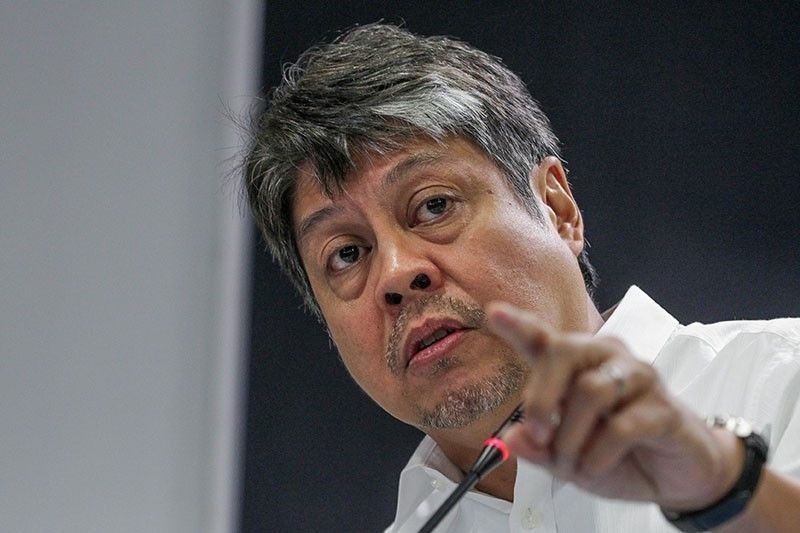
The latest statement of paranoia of Senator Francis Pangilinan inferring that China is launching a “soft invasion” in the Philippines because of the increasing number of Chinese retirees and workers in the country is not only absurd and far-fetched but for the most part, is simplistic and precariously misleading.
Such a paranoid statement coming from Pangilinan was supported by his ally in the likes of Senator Risa Hontiveros who said that “a staggering” four million Chinese nationals have streamed into the country since 2017.”
Vice President Leni Robredo has also verbalized her xenophobia saying that, “the number of Chinese in the Philippines are ‘dangerous’ to our national security.”
Senator Richard Gordon chimed-in expressing alarm over the number of Chinese retirees in the country.
These unsubstantiated and unfounded paranoia from these political personalities stemmed from the recent Department of Tourism (DOT) senate budget hearing, where Senators have questioned the practice of the Philippine Retirement Authority (PRA) to allow foreigners as young as 35 years old to reside in the country as retirees.
Based on PRA data provided by the DOT, some 26,969 Chinese nationals have been allowed to retire in the Philippines, topping the list as of December 2019, followed by 13,912 Koreans; 5,951 Indians; 4,801 Taiwanese; and 3,950 Japanese. Other foreign retirees include 3,615 Americans; 1,836 Chinese from Hong Kong; 1,571 British; 778 Germans; 743 Australians; and some 4,069 unidentified nationalities.
When reminded that this policy was formulated in 1993 during the administration of President Fidel Ramos, and not the present Duterte regime, to court South Korean military retirees, Senator Gordon said, “I don’t care about Korea. We have a problem with our neighbor [China].”
Gordon was chairman of the PRA when he served as DOT secretary from 2001-04 during the presidency of Gloria Macapagal Arroyo. He did nothing about what he is now complaining about.
Is this because he lacked the wisdom then because the Chinese started sharing its outbound tourist traffic only in 2016 after the term of President BS Aquino because the latter adopted a foreign policy hostile to China?
As of full-year 2015, we had only 360,000 Chinese tourists. In just three full years, this increased more than tenfold to 4 million.
Or is it because as a grandson of an American immigrant, he grew up in Olongapo City, heavily influenced by the US Naval Base in Subic Bay, a facility he transformed into a freeport zone as chairman of the Subic Bay Management Auhtority from 1992-98 and before that mayor of Olongapo from 1988-93?
Globalizing
George Siy, a Wharton-educated economic analyst and director of the Integrated Development Studies Institute (IDSI), a Manila-based think-tank, however, dismissed fears of a China “soft invasion”.
Instead, Siy highlighted that the Philippines is globalizing.
He said, “our neighbors are also experiencing and managing to capitalize on the economic opportunities brought about by the ‘China wave’ to help fast-track their countries’ development.
Siy also noted that Chinese lending to the Philippines through concessional loans for dams and irrigation projects meant to create more or less 15,000 jobs and provide for the development needs of the country for decades. He said that “although some Chinese workers are employed locally for their special skills, far more jobs are created for Filipinos by the Chinese-funded projects.”
However, the IDSI director posed a caveat that like in any relationship, there are always issues that must be managed.
“Like a basket of fruits, there are always bad apples. We don’t throw away the whole basket. We manage the basket, remove bad apples and capitalize on the good apples,” he said.
He also added that “sadly, some isolated issues are overblown due to emotions or vested interests. Many developments are not reported while negative ones are headlined.”
Fake News on Chinese vs Filipino Workers
In the same Senate hearing on the topic of “soft invasion” it was asserted that, Chinese nationals make up 45 percent of the Department of Public Works and Highways’ (DPWH) “Binondo-Intramuros (BI) Bridge Project” while in the “Estrella-Pantaleon (Makati City) project”, 31 percent of the workers there were also made up of Chinese nationals.
Such contention was disputed by the Chinese Ambassador to the Philippines. Ambassador Huang Xilian has expressed that Chinese employees only account for less than 8 percent of the total staff involved in projects being implemented by Chinese enterprises in the Philippines.
Huang emphasized that the BI Bridge Project has resumed full capacity currently with 128 Filipino and 37 Chinese employees working on site. The local employees account for 77.6 percent of the total staff with still more local workers to be hired as the implementation dives deep, while Chinese employees are mainly managerial and technical personnel.
Based on the latest statistics, about 50 large-scale Chinese enterprises based in the Philippines have employed more than 18,000 Filipinos so far, and the number is expected to increase in the coming years.
Huang further stressed that “Chinese enterprises in the Philippines have always attached great importance to localized development, always intending to hire local people as many as possible, being keen to practice technology transfer to the local and actively perform social responsibilities to better integrate into local society.
The operations of Chinese companies in the Philippines have been inevitably affected due to the pandemic and local quarantine measures. Nevertheless, some major Chinese enterprises still created about 38,000 jobs for the local society, while the local employee hiring rate accounts for more than 92 percent.”
Huang also emphasized, “as the bilateral relations between China and the Philippines more particularly on economic and trade cooperation further deepens, of China-Philippine, more and more job opportunities would be created.”
Let us put all these perceptions and acquired hindsight about “soft invasion” in their proper context and set the record straight.
Proof of History
Firstly, China does not have a history of invading other countries.
China has not subjugated any country since the founding of the People’s Republic of China. It never provoked a war, nor occupied an inch of others’ land.
For the past three decades, China’s defense expenditure as a percentage of Gross Domestic Product (GDP) has remained more or less two percent, far behind that of the United States (US) and other major countries.
It has a single overseas military base in Djibouti in the Horn of Africa for defensive purposes, unlike the United States (US) that has 38 military bases across the globe.
To quote former US President Jimmy Carter who used to compare the US with China, “the US has only enjoyed 16 years of peace in its 242-year history, making the country the most warlike nation in the history of the world,” while China has been “at peace” and has sensibly invested in infrastructure to achieve “breakneck growth”.
Likewise, one has to be cognizant as well of the fact that, unlike American “exceptionalism” and “unilateralism”, where the US spreads its values and its typology of democracy across the globe, which has led to wars and invasions, China does not proselytize.
That Muslims have more than 1,200 year chronology in China says it all.
It does not claim that its contemporary institutions are relevant outside its borders. It never did and it never espoused the American notion of “universalism” and “neocolonialism” to spread its values and political ideology around the world.
To note, “neocolonialism” is the practice of using economics, globalization, cultural imperialism, and conditional aid to influence a country instead of the previous colonial methods of direct military control (imperialism) or indirect political control (hegemony), while “universalism” is the philosophical/theological concept that some ideas have universal application or applicability.
Sino-Philippine Bilateral Relations
Second, it is not entirely true that we have a problem with China, though it is a fact that we have competing maritime claims with China over the disputed waters of the South China Sea (SCS). However, this does not mean that China-Philippine bilateral relations are entirely conflict-driven. The Philippine dispute with China over the SCS does not define the totality of the bilateral relations of both countries.
The SCS dispute is just a small part of China-Philippines relations. Just like what Foreign Secretary Locsin said, “the SCS is just a little pebble on the avenue leading to our mutually beneficial economic progress, and we mustn’t stumble over the little pebble.” This means that the dispute over the SCS between the Philippines and China should not be treated and envisaged as a “zero-sum game” for it is not.
One has to remember that Philippines-China relations have improved under the Duterte administration from “icy and antagonistic diplomatic ties” under the previous administration to more “friendly and constructive relations”.
This “New Golden Age” of Sino-Philippine relations had thus far further strengthened mutual political trust, practical cooperation, and people-to-people exchanges, which have not only benefited both the Chinese and Filipinos but also contributed to the regional stability and prosperity.
Furthermore, it is but a fact that the Philippines had benefited economically from the warming relationship with China through trade and investment, and other economic activities like the ‘Build, Build, Build’ program of the Duterte administration, which the country has gained a lot.
To add, the total value of China’s newly signed contracts of projects in the Philippines still scored an increase of 26.5 percent in the first half of this year (2020) despite the coronavirus pandemic, which highlights the huge potential of the bilateral cooperation between China and the Philippines.
And concerning the paranoia of some political personalities that the Philippines will be in a “debt trap” with China, this is quite an overstatement. To note, the Bangko Sentral ng Pilipinas (Central Bank of the Philippines) has already disclosed that loans from China only accounts for merely 0.65 percent of the country’s total debt. Even if all the planned financing were implemented, the figure would only be around 4.5 percent by 2022, still much lower than that of other major foreign lenders.
Chinese Retirees
To set the record straight, there are only a total of 14,987 active retirees or those who continue to keep the retirement visa as their status of stay in the Philippines ages 34 to 49 years old.
Out of the total number of active retirees, more than 50 percent or 8,130 are Chinese nationals from mainland China, followed by the Koreans at 2,257, and Indians at 1,891.
Many of these Chinese retirees buy condominiums, and most if not many of them are investing and doing business (start-up businesses) in the country. These Chinese retirees also invite their friends to visit the Philippines as tourists, which to a greater extent helps boost the country’s tourism prospects and promotion.
Take note, China continues to be an important source of tourists for the Philippines. Data from the DOT showed that a total of 1.74 million Chinese tourists visited the Philippines in 2019, a 38.58 percent increase from 2018.
Contrast this to only 360,000 in President Aquino’s last full year.
These Chinese tourists spent a total of $2.33 billion as they visited the Philippines in 2019. To date, China remains the second-largest tourism market for the Philippines.
It is thus far an economic engine for the country that other countries are working hard to court and attract. Even Western countries are extending subsidies just to attract Chinese tourists.
Conclusion
To demonize China and accuse it of orchestrating a “soft invasion” in the Philippines is more or less a product of Pangilinan’s twisted figment of imagination devoid of concrete and solid evidence, or probably an early electioneering stunt to call attention to himself.
In the same manner that the latest utterances of paranoia from the likes of Pangilinan, Hontiveros, and Gordon, are not only groundless and misleading but most of all is bizarre and unwise.
These are upshots of their ulterior political motives, which in many ways if entertained, may severely affect, undermine, and damage the good relations between China and the Philippines, and between the Chinese and the Filipino people.
Just to emphasize, there’s never been any evidence for that matter that Chinese sponsored or funded projects in the Philippines have threatened the national security of the country. On the contrary, these development infrastructure projects are contributing much to the national development of the Philippines.
The Philippines as a country must consider its interests on a “multi-dimensional-long-term basis,” and should not be distracted by the noise of certain political personalities, who are just spoiling for a fight, and raising unnecessary tension and controversy, which nothing good will come out of it. In the era of Covid-19, cooperation between China and the Philippines is indispensable and vital to the country’s survival, stability, and peace.
Source: Sovereign PH
https://sovereignph.com/2020/11/02/soft-invasion-or-paranoia/
https://sovereignph.com/2020/11/04/soft-invasion-or-paranoia-2/



